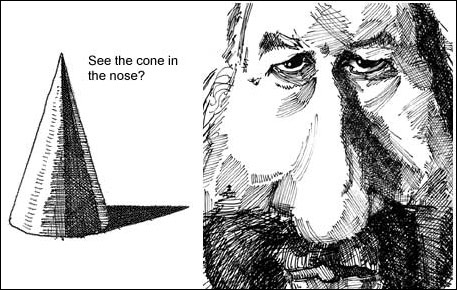| X-Attachments: C:\nose_cone_for_road.jpg;
June 30th 2001 (picture below) ********************************************************** YouCanDraw.com's Insider Communiqué ********************************************************** In today's issue: 1) Question about using media other than pencil from member John Beales of Elizabeth City, North Carolina 2) Very brief look at breaking down the face into primitive forms: starting with the nose 3) Reviewing the very user-friendly usage rights ------------------------------------------------------------------------------- 1) Member John Beales writes: "I have noticed different caricature artists using markers, pastels, pens etc. I am interested in using pastels as well as others...In any of the course do you teach working in different mediums?" ANS: Great question John Getting a firm idea for the basic elements - like line, light and shadow, angles, proportion, perspective - learning those is job number one - but you can experiment in whatever medium you wish (my favorite is watercolor). Once you get a feel for what the basics are, color becomes an immediate offshoot. An offshoot of what you might ask? An offshoot most specifically of recognizing shadows, shadow shapes and tones/values/shades within those shadows and shadow shapes. Shadow tones and values are just different "colors" of gray. It's all a matter of observation. With that under your belt - that is, learning to differentiate different shades of gray - it's easiest to start working into color using or pastels or pens or paints (but again - you can and ought to experiment any time you get the whim:-) . Lesson 9 is gives you a pretty thorough walk through of using shadows, highlights and recognizing shadows as shapes. See lesson 9 (even though it says "lesson 10") on-line at: http://ycdinsiders.digitalchainsaw.com/InsidersArtistLoft/lesson10.htm So to really answer your question John, I don't get too deep into color - but by learning the basics, you can make the leap. Please feel free to throw any questions you might have at me as you go John. I'll do my best to answer them (if you want to mail something for evaluation - feel free to do that too :-) emailing a copy is ok too as long as it's under 100 kb. (that's pretty small - but big enough to see what you're doing). So dive on in and don't be afraid! - thanks again for your question. 2) Primitive forms and constructing the face and head in three dimensions We were just talking about shadows and colors and shadow shapes above, and that's a great lead in to the next section here. When you're drawing, you're generally reducing the three dimensional world "out there" to the two dimensions of the paper. How does the mind recognize three dimensions on two dimensional paper? The short answer? Three different ways, through: 1) proportion, 2) perspective and 3) shadowing. Geometric Forms In June 5th's Communiqué we talked about geometric forms (not to worry new members, the archives will be updated this month and you'll have access to all the old e-zines and caricatures). When constructing a face or head, the ability to see it and reduce it to geometric forms is a great technique. For instance, seeing the face as a construct of five different 3-d shapes helps you to instantly perceive a person's underlying bone structure (yep, just like x-ray vision!) [See lesson 14, section 7 for an in-depth exploration of these five building blocks of the face: http://ycdinsiders.digitalchainsaw.com/InsidersArtistLoft/section7a.htm ] Five main building blocks of the face Those five main building blocks of the face: the forehead, cheekbones, nose, maxilla, and jaw can be reduced further to some combination of the "primitive forms". What are the main three dimensional primitive forms? They're the sphere, the cube, the cone, and the cylinder. What's the use of that? The beauty of recognizing these forms within the features and parts of the face is at least two-fold. First, when you know how to draw the different primitive geometric shapes, you instantly have a built-in template in your brain to build from. (If you're just beginning it's this referencing you want to avoid - if you're just beginning learning to see what is in front of you is always your first task.) Seeing these forms in your subject helps speed up your drawing because you know for instance, an elliptical shape can be derived from a sphere, a cone from combining a triangle and a cylinder - and again, the face can be reduced to all of these. Light, geometric shapes and your drawings More importantly, if you understand how light responds and behaves on the different geometric forms and you know the source the light hitting your subject is coming from, it's a slam dunk: you can recognize instantly where on a face the shadows ought to be falling. That way you can look for them, you'll know where to find them and thus correctly place them in your drawing - adding tremendously to it's three dimensional appearance. See the attached illustration In the attached illustration check out the shape of the cone on the left and see if you can't visualize it within the caricatured nose on the right. Squint - this will help to collapse the detail into identifiable shapes.
Jeffrey O. Kasbohm
|
